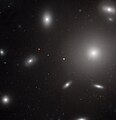Súbor:NGC 4874 HST.jpg

Veľkosť tohto náhľadu: 578 × 600 pixelov. Iné rozlíšenia: 231 × 240 pixelov | 463 × 480 pixelov | 740 × 768 pixelov | 987 × 1 024 pixelov | 1 973 × 2 048 pixelov | 3 864 × 4 010 pixelov .
Pôvodný súbor (3 864 × 4 010 pixelov, veľkosť súboru: 5,95 MB, MIME typ: image/jpeg)
História súboru
Po kliknutí na dátum/čas uvidíte ako súbor vyzeral vtedy.
| Dátum/Čas | Náhľad | Rozmery | Používateľ | Komentár | |
|---|---|---|---|---|---|
| aktuálna | 11:55, 20. september 2011 |  | 3 864 × 4 010 (5,95 MB) | Jmencisom |
Použitie súboru
Na tento súbor odkazuje nasledujúca stránka:
Globálne využitie súborov
Nasledovné ďalšie wiki používajú tento súbor:
- Použitie na ar.wikipedia.org
- Použitie na arz.wikipedia.org
- Použitie na ast.wikipedia.org
- Použitie na az.wikipedia.org
- Použitie na be.wikipedia.org
- Použitie na ce.wikipedia.org
- Použitie na cs.wikipedia.org
- Použitie na de.wikipedia.org
- Použitie na diq.wikipedia.org
- Použitie na en.wikipedia.org
- Použitie na et.wikipedia.org
- Použitie na eu.wikipedia.org
- Použitie na fr.wikipedia.org
- Použitie na hr.wikipedia.org
- Použitie na it.wikipedia.org
- Použitie na ja.wikipedia.org
- Použitie na kk.wikipedia.org
- Použitie na ko.wikipedia.org
- Použitie na mk.wikipedia.org
- Použitie na nl.wikipedia.org
- Použitie na pl.wikipedia.org
- Použitie na ru.wikipedia.org
- Použitie na sl.wikipedia.org
- Použitie na tt.wikipedia.org
- Použitie na uk.wikipedia.org
- Použitie na uz.wikipedia.org
- Použitie na www.wikidata.org
- Použitie na zh.wikipedia.org
